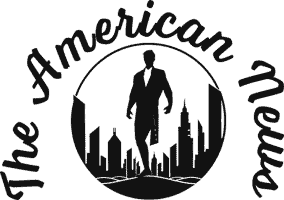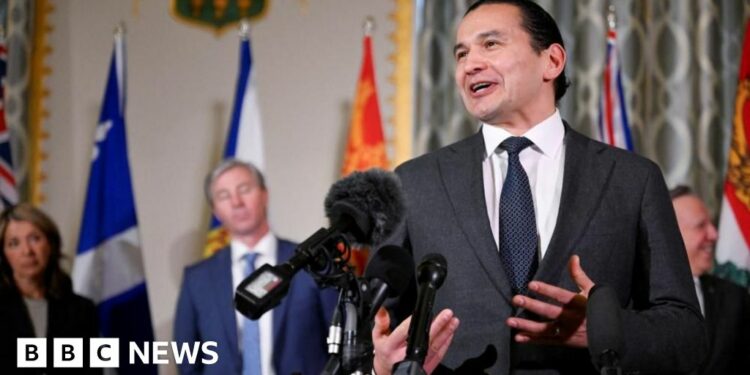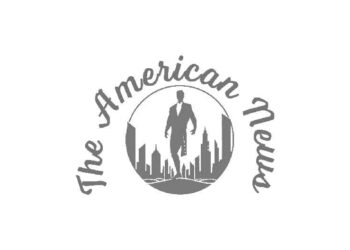Brandon Drenon in Washington DC & Jessica Murphy in Toronto
BBC News
Watch: Canadian premiers gather in DC to make their case against tariffs
Canada’s provincial and territorial leaders say they had a “constructive” meeting at the White House as they sought to make their case against the tariffs the US president has threatened to impose on the country.
It is the first time all 13 premiers have visited the US capital together, illustrating how seriously a potential trade war is viewed by Canada.
President Donald Trump’s threat to impose 25% import taxes on all goods from Canada, and 10% on energy, was paused for 30 days earlier this month after Canada adopted new border measures.
On Monday, Trump added another threat, saying he planned to add a 25% tax on all global steel and aluminium imports to the US beginning 12 March.
On Wednesday afternoon, the premiers secured a last-minute meeting with senior Trump advisers after spending the day sitting down with US lawmakers.
“We had a very constructive conversation,” Ontario Premier Doug Ford told reporters as the premiers who attended the meeting left the White House.
British Columbia Premier David Eby said White House advisers “urged us to take the president at his word” on Trump’s stated reasons for the tariffs, such as border security and ensuring the US is not taken advantage of in trade relationships.
“There were some very frank moments across the table,” he said.
The premiers’ overall message is that the two countries are better as economic allies, and that Canada is a secure partner for commodities like energy, metals and critical minerals.
More than 75% of Canada’s exports go to the US and the two economies are highly integrated.
If the steel and aluminium tariffs go ahead it will particularly affect Canada, which supplies the US with more of the products than any other country.
If both the metals and blanket tariffs come into force they would stack, essentially doubling the steel and aluminium tariffs on Canada.
Also on Wednesday, Canada’s Finance Minister Dominic Leblanc met Howard Lutnick, Trump’s pick to lead the commerce department, and Kevin Hassett, the director of the National Economic Council.
He said they discussed how deeply integrated the steel and aluminium sectors are between the two countries.
“I’m confident we have their attention,” he said.
Trump has said the metals tariffs would boost domestic US production.
White House spokeswoman Karoline Leavitt on Wednesday said: “This administration believes these tariffs will protect our national security and put American workers first.”
On the wider 25% tariffs on all Canadian imports, Trump has cited concerns over illegal immigration and the flow of drugs into the US from its neighbours.
Canada has vowed swift retaliation to Trump’s tariffs though it has said the ultimate goal is to avoid any levies.
On Tuesday, Canadian Prime Minister Justin Trudeau appointed a new fentanyl tsar as part of his country’s efforts seeks to address border concerns.
Kevin Brosseau, a former member of the Royal Canadian Mounted Police and intelligence adviser to Trudeau, will take on the role immediately.
He is expected to be in Washington DC in the coming days.
Speaking at a news conference near the Ontario-New York border, he said he will focus on joint US-Canada efforts to target fentanyl trade.
Less than 1% of fentanyl intercepted at the US border comes from Canada, according to figures from Ottawa.
“Getting the number to zero is in fact a goal, and should be our goal,” Mr Brosseau said.
Canada is implementing a $1.3bn (£1bn) border plan that includes nearly 10,000 frontline workers and more resources to halt the flow of fentanyl, a synthetic drug 50 times stronger than heroin. Much of it was announced before Canada and the US hammered out the tariff pause.
There are also new Black Hawk helicopters and drones to monitor the 8,890km (5,525 mile) boundary.
Since returning to the White House last month, Trump has been in one trade standoff with Canada and America’s other neighbour, Mexico.
He agreed on 4 February to delay for 30 days his threat of 25% tariffs on all goods arriving from both countries.
Trump has framed tariffs as a tool for growing the US economy, protecting jobs and raising tax revenue.
Economists, however, have warned that tit-for-tat tariffs could raise prices for a wide range of products, including cars, lumber, steel, food and alcohol.
Canada and Mexico are the top US trade partners, along with China.
Trump moved forward with a 10% tariff on all goods entering the US from China, which as retaliated with countermeasures against US goods.
Source link : http://www.bing.com/news/apiclick.aspx?ref=FexRss&aid=&tid=67ad4994c13c4695a80ad71293db05c5&url=https%3A%2F%2Fwww.bbc.com%2Fnews%2Farticles%2Fcj91xrp4zyjo&c=775139680437421324&mkt=en-us
Author :
Publish date : 2025-02-12 11:13:00
Copyright for syndicated content belongs to the linked Source.





